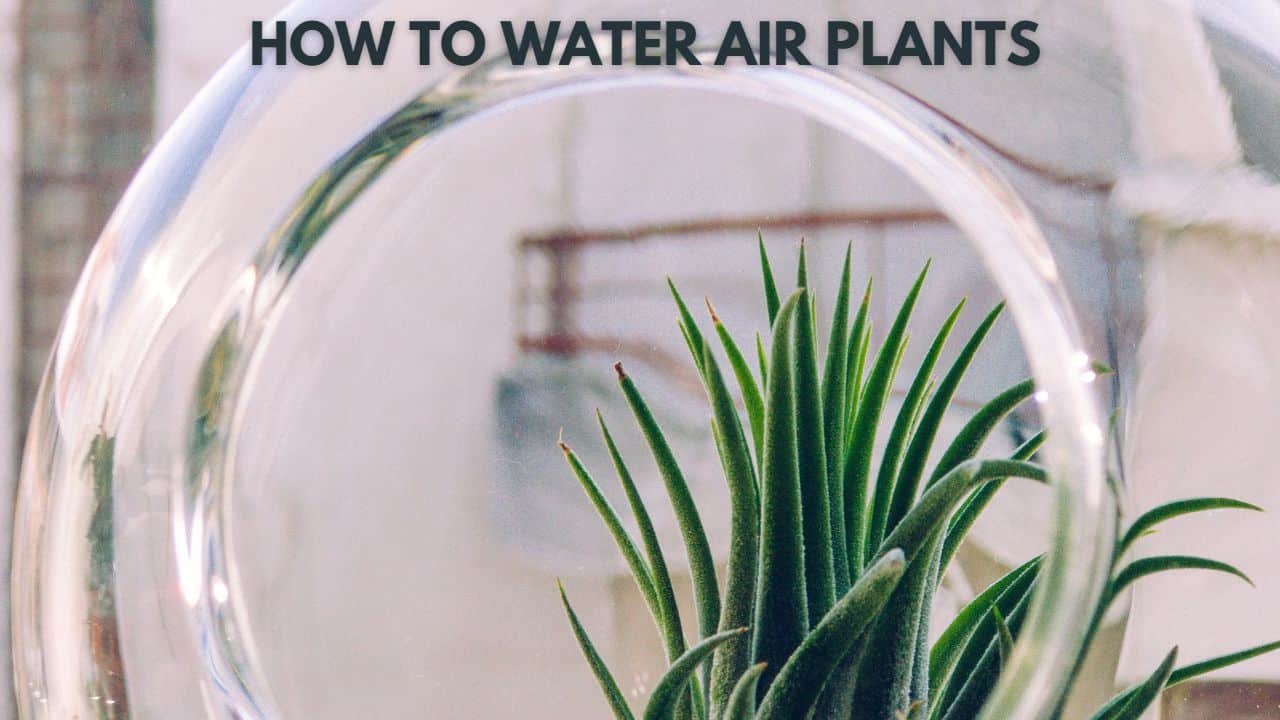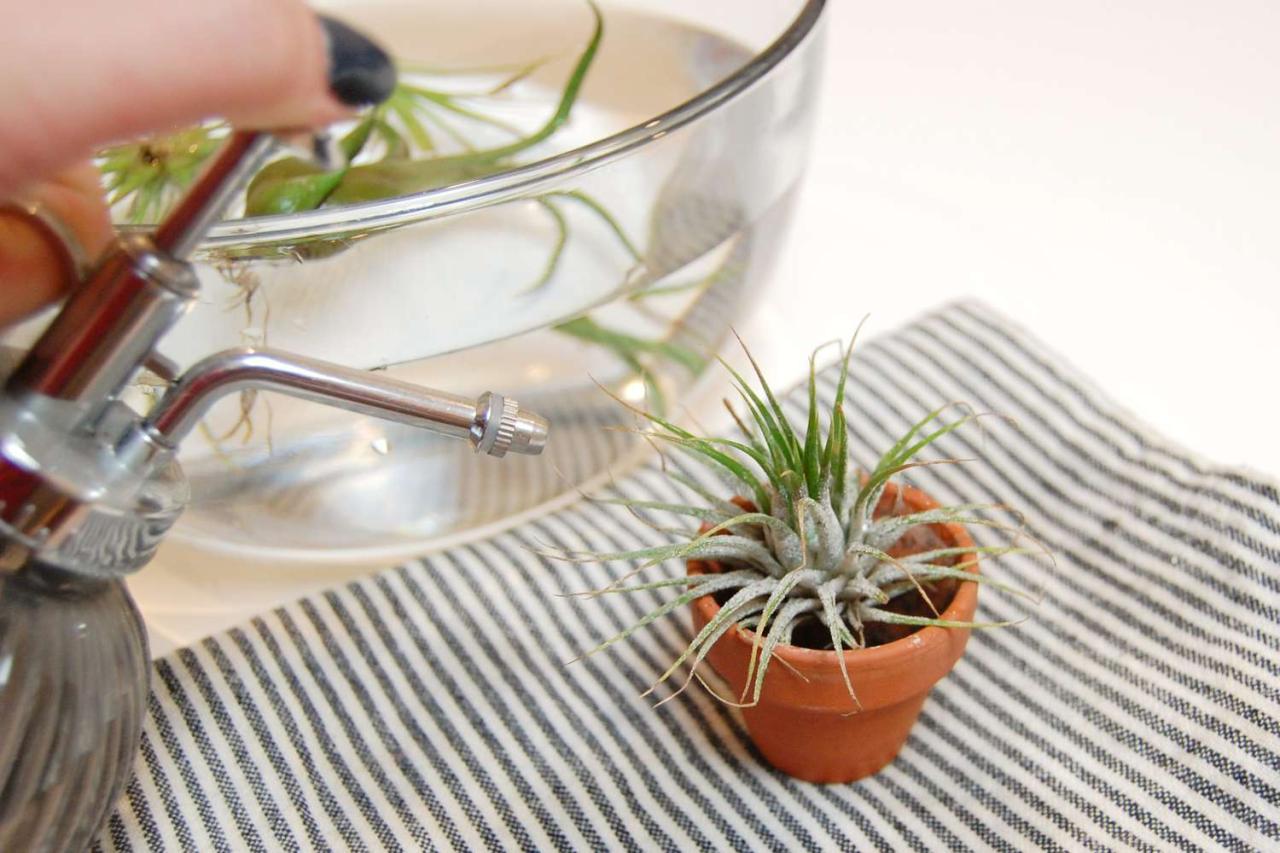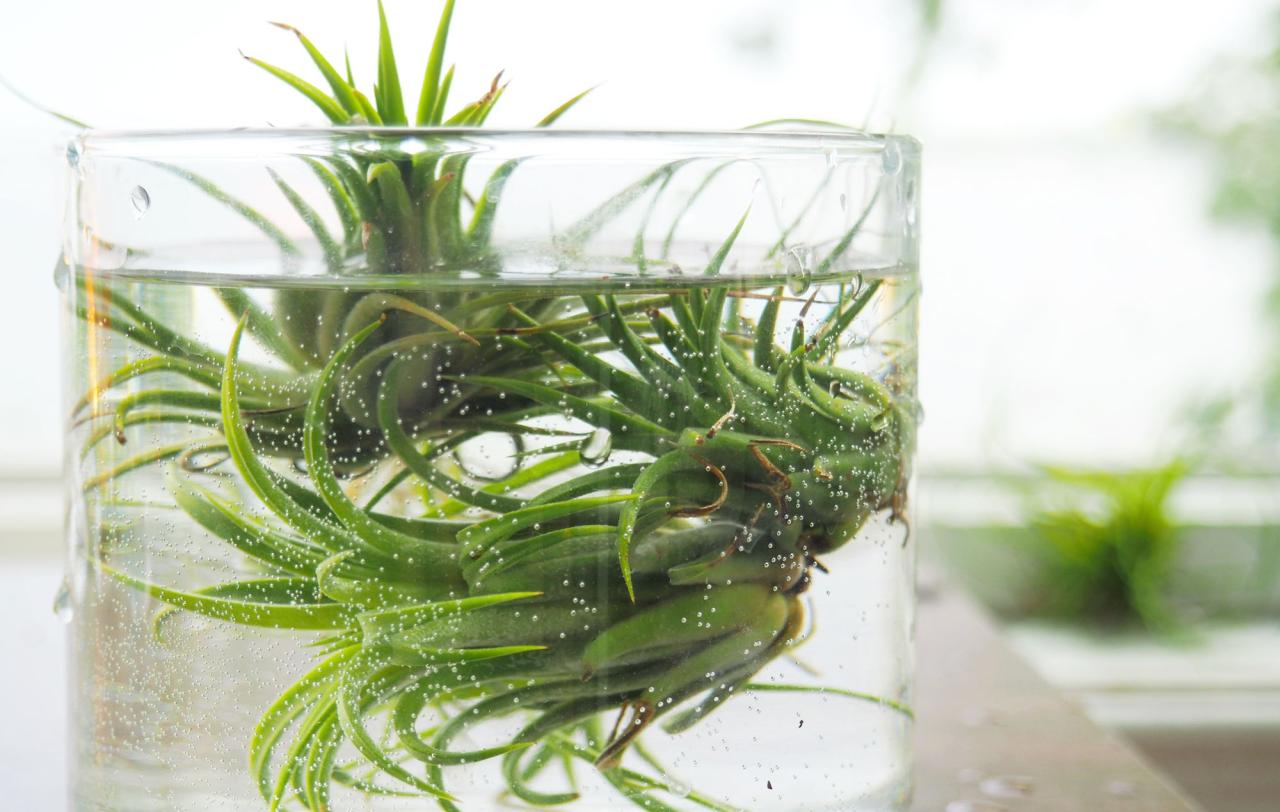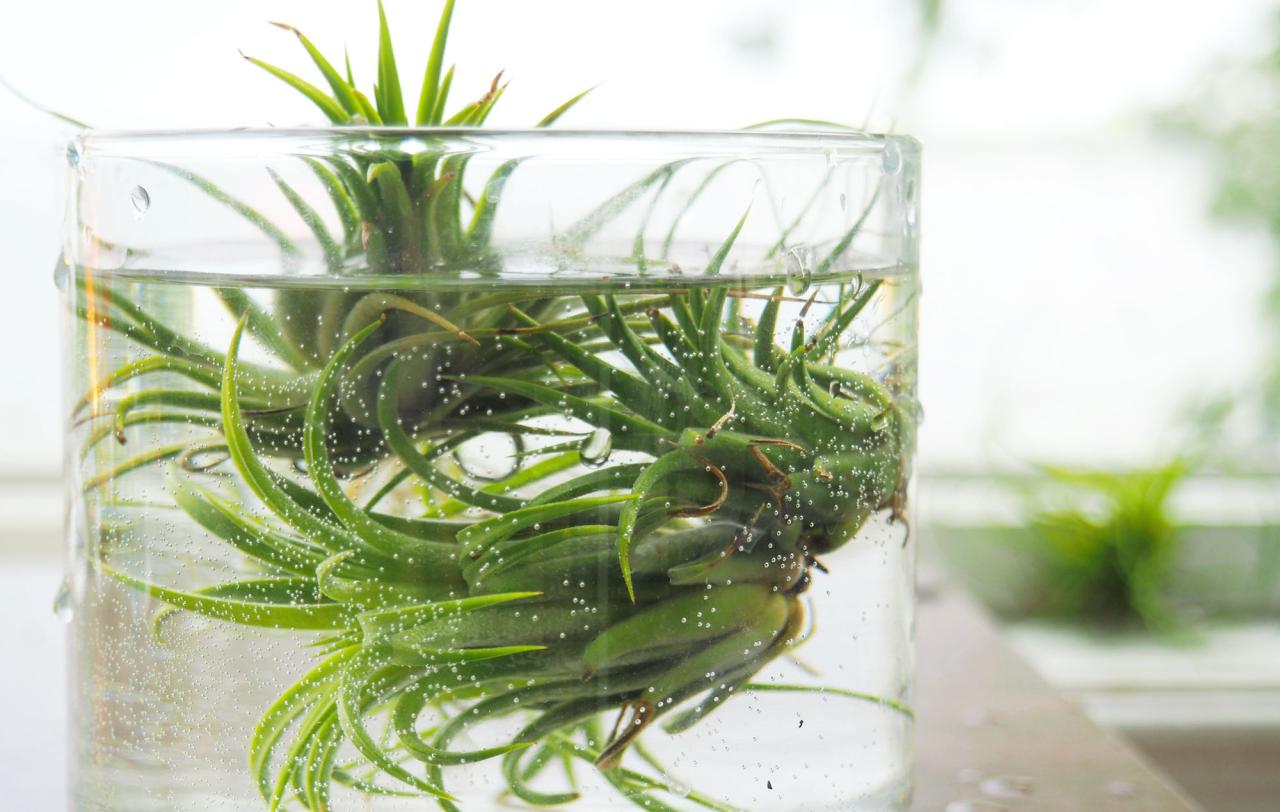The Dos and Don’ts of Watering Air Plants: Air plants, also known as epiphytes, are fascinating botanical wonders that thrive without soil. These unique plants absorb moisture and nutrients from the air, making them a popular choice for indoor gardeners.
While their care seems simple, mastering the art of watering air plants requires understanding their specific needs. This guide delves into the essential dos and don’ts of watering air plants, ensuring their healthy growth and vibrant appearance.
Air plants are surprisingly low-maintenance, but their watering requirements differ from traditional plants. Unlike their soil-bound counterparts, air plants absorb moisture through their leaves, making it crucial to understand the nuances of their hydration process. This guide will cover the optimal frequency, water type, and soaking techniques for ensuring your air plants thrive.
We’ll also discuss common mistakes to avoid, like overwatering and underwatering, and provide tips for reviving a plant that’s been neglected.
Understanding Air Plants
Air plants, also known as epiphytes, are fascinating and unique plants that thrive without soil. Unlike traditional plants that rely on soil for nutrients and moisture, air plants absorb these essentials directly from the air and their surroundings. This adaptation allows them to flourish in diverse environments, often clinging to trees, rocks, or other surfaces.
Types of Air Plants and Their Watering Needs
Air plants belong to the Bromeliaceae family, which encompasses a wide range of species. The most common types of air plants include:
- Tillandsia ionantha (Pink Quill):This popular air plant features vibrant pink blooms and prefers moderate watering, allowing the plant to dry completely between waterings.
- Tillandsia xerographica (Xerographica):Known for its striking silver-green leaves, this air plant requires infrequent watering, as it can store moisture efficiently.
- Tillandsia aeranthos (Sky Plant):This species exhibits a diverse range of colors, including pink, purple, and red, and thrives with regular watering, ensuring the plant stays slightly moist.
While all air plants require water, their specific needs vary depending on the species. Some air plants, like the Tillandsia xerographica, are adapted to arid environments and can tolerate infrequent watering, while others, such as the Tillandsia aeranthos, require more frequent hydration.
Common Misconceptions about Air Plants
Several misconceptions surround air plants, particularly regarding their watering requirements:
- Myth: Air plants don’t need water.This is a common misconception. Air plants still require water to survive and thrive. They absorb moisture from the air and their surroundings, but they need regular watering to maintain their health.
- Myth: Air plants should be submerged in water.Submerging air plants in water for extended periods can lead to root rot and damage. Air plants prefer to be misted or soaked for a short duration, allowing them to absorb the water quickly.
- Myth: Air plants need direct sunlight.While some air plants tolerate direct sunlight, others prefer indirect light or even shade. It’s crucial to understand the specific light requirements of your air plant species.
The Dos of Watering Air Plants

Watering air plants correctly is essential for their health and longevity. Unlike traditional plants, air plants absorb water and nutrients through their leaves, making the watering process unique. This section will delve into the dos of watering air plants, focusing on the water type, frequency, and technique.
Using the Right Type of Water
The quality of water used for air plants plays a crucial role in their growth and health. Tap water often contains minerals and chemicals that can build up on the leaves and harm the plant. Therefore, using filtered or purified water is recommended.
- Filtered water: Water that has been filtered through a carbon filter removes chlorine and other impurities that can be harmful to air plants.
- Rainwater: Naturally soft and free of chemicals, rainwater is an ideal choice for watering air plants.
- Distilled water: Water that has been distilled removes all minerals and impurities, making it the purest option for air plants.
Watering Frequency
The frequency of watering air plants depends on several factors, including the environment, season, and type of air plant.
- Environment: Air plants in dry environments, such as those with low humidity, require more frequent watering than those in humid environments.
- Season: During the warmer months, air plants require more frequent watering due to increased transpiration. In winter, they need less frequent watering as their growth slows down.
- Type of air plant: Some air plants, like Tillandsia ionantha, require more frequent watering than others, like Tillandsia xerographica.
Soaking Air Plants
The most effective way to water air plants is by soaking them in water.
- Fill a bowl or sinkwith filtered or purified water.
- Submerge the air plantin the water for 20-30 minutes. Ensure the entire plant is submerged, allowing the leaves to absorb water.
- Remove the air plantfrom the water and gently shake off any excess water.
- Allow the air plantto dry completely before placing it back in its usual location. This prevents root rot and promotes healthy growth.
The Don’ts of Watering Air Plants
While air plants are remarkably resilient, they are susceptible to the consequences of improper watering practices. Overwatering and underwatering are two common mistakes that can negatively impact their health and longevity. Understanding these pitfalls and how to address them is crucial for ensuring your air plants thrive.
Consequences of Overwatering, The Dos and Don’ts of Watering Air Plants
Overwatering is a common mistake that can lead to various issues, including root rot, fungal infections, and even death. Air plants, unlike traditional potted plants, do not have roots that absorb water from the soil. Instead, they absorb moisture through their leaves.
When overwatered, air plants can become waterlogged, leading to root rot and other complications.
Air plants should never be fully submerged in water for extended periods.
While air plants are known for their low-maintenance nature, proper watering is crucial to their well-being. Overwatering can lead to root rot, while underwatering can cause them to dry out and become brittle. To avoid these issues, it’s best to soak your air plants in water for 10-15 minutes once a week, then allow them to fully dry before returning them to their display.
If you’re looking to expand your air plant collection, you can easily propagate new plants by taking cuttings from existing ones. A helpful guide on taking cuttings from hanging plants can be found here , which can also be applied to air plants.
Once your new air plants are established, you can follow the same watering routine as your existing ones, ensuring they thrive in your home.
Overwatering is a common mistake that can lead to various issues, including root rot, fungal infections, and even death. Air plants, unlike traditional potted plants, do not have roots that absorb water from the soil. Instead, they absorb moisture through their leaves.
When overwatered, air plants can become waterlogged, leading to root rot and other complications.
Air plants should never be fully submerged in water for extended periods.
- Root rot:This occurs when the roots of the air plant become damaged due to excessive moisture, leading to a lack of oxygen and nutrient absorption.
- Fungal infections:Excess moisture creates a favorable environment for fungal growth, which can damage the leaves and eventually kill the plant.
- Stunted growth:Overwatering can hinder the plant’s growth by inhibiting nutrient absorption and causing leaf discoloration.
- Premature death:In severe cases, overwatering can lead to the death of the air plant.
Consequences of Underwatering
Underwatering, while less common, can also harm air plants. Air plants require regular watering to stay hydrated and perform photosynthesis. When underwatered, they may become dehydrated and stressed, leading to leaf browning, wilting, and eventually death.
Air plants should be watered at least once a week, depending on the environment and the plant’s specific needs.
- Leaf browning:This is a common sign of dehydration, indicating that the air plant is not receiving enough moisture.
- Wilting:Dehydrated air plants may appear limp and wilted, losing their structural integrity.
- Stunted growth:Underwatering can slow down the plant’s growth rate, as it lacks the necessary moisture for optimal development.
- Premature death:In severe cases, prolonged underwatering can lead to the death of the air plant.
Reviving an Overwatered Air Plant
If you suspect your air plant has been overwatered, take immediate action to revive it.
- Remove excess moisture:Gently pat the air plant dry with a clean towel to remove any excess water.
- Allow the plant to air dry:Place the air plant in a well-ventilated area, away from direct sunlight, to allow it to dry completely.
- Monitor for signs of improvement:Observe the air plant for any signs of improvement, such as new growth or a return to its natural color.
Reviving an Underwatered Air Plant
If your air plant is showing signs of underwatering, you can revive it with a few simple steps.
- Soak the plant in water:Submerge the air plant in a bowl of lukewarm water for 30-60 minutes, ensuring the entire plant is submerged.
- Allow the plant to drain:Remove the air plant from the water and allow it to drain thoroughly.
- Place the plant in a humid environment:Place the air plant in a humid environment, such as a bathroom or a terrarium, to help it recover.
Air Plant Care Beyond Watering
While proper watering is crucial for air plant health, it’s just one aspect of their care. Providing adequate light, humidity, and temperature, as well as protecting them from pests and diseases, is essential for their long-term well-being.
Light Requirements
Air plants thrive in bright, indirect light. They can tolerate some direct sunlight, especially during cooler months, but prolonged exposure can scorch their leaves. Ideally, they should be placed in a location that receives at least four hours of bright, indirect light daily.
Creating a Suitable Environment
Humidity
Air plants prefer humid environments. You can increase humidity by placing them on pebble trays filled with water, using a humidifier, or grouping them together.
Temperature
Most air plants prefer temperatures between 60°F and 85°F. They can tolerate slightly cooler temperatures, but extreme heat can be detrimental. Avoid placing them near heat sources or in direct sunlight during the hottest months.
Pests and Diseases
Common Pests
- Mealybugs:These tiny, white, cottony insects feed on plant sap and can cause stunted growth. They can be removed with a cotton swab dipped in rubbing alcohol.
- Scale:These insects resemble small, hard bumps on plant leaves. They can be treated with horticultural oil or insecticidal soap.
- Aphids:These small, soft-bodied insects can be green, brown, or black. They suck sap from plants and can cause leaf curl and distortion. They can be controlled with insecticidal soap or a strong spray of water.
Common Diseases
- Root Rot:This fungal disease can occur when air plants are overwatered or exposed to excessive moisture. Symptoms include brown or mushy leaves and a foul odor. Affected plants should be removed and discarded.
- Leaf Spot:This fungal disease can cause brown or black spots on leaves. It can be treated with a fungicide or by improving air circulation around the plants.
Prevention and Treatment
- Regular Inspection:Inspect your air plants regularly for signs of pests or diseases. Early detection is key to successful treatment.
- Isolation:Isolate any infected plants to prevent the spread of pests or diseases to other plants.
- Proper Watering:Avoid overwatering, as this can create conditions that favor fungal growth.
- Good Air Circulation:Ensure good air circulation around your air plants to prevent fungal growth and discourage pests.
Creative Display and Care

Air plants, with their unique ability to thrive without soil, offer a wide range of creative display options. From hanging planters to terrariums, the possibilities are endless. This section explores creative ways to showcase these fascinating plants, while also providing essential care tips for maintaining their health and beauty in different display settings.
Creative Display Ideas
Air plants can be displayed in various creative ways, adding a touch of natural beauty and unique character to any space. Here are some innovative ideas:
- Hanging Planters: Air plants can be suspended in mid-air using macrame hangers, wire baskets, or even repurposed teacups. These hanging displays add a touch of bohemian charm and can be easily incorporated into a variety of interior design styles.
- Terrariums: Terrariums provide a mini-ecosystem for air plants, allowing you to create a self-contained world. These glass enclosures can be filled with decorative elements like rocks, moss, and even miniature figurines, creating a whimsical and captivating display.
- Decorative Holders: Air plants can be displayed in a variety of decorative holders, such as ceramic bowls, glass orbs, or even seashells. These holders can be chosen to complement the existing decor of the space, adding a touch of natural elegance.
Innovative Incorporation into Home Decor
Air plants can be seamlessly integrated into home decor, adding a touch of greenery and sophistication to various spaces. Here are some innovative ideas:
- Wall Art: Air plants can be used to create stunning wall art, by attaching them to wooden panels, cork boards, or even repurposed driftwood. This creates a unique and eye-catching display, adding a touch of natural beauty to any wall.
While air plants don’t require traditional soil, understanding their watering needs is crucial. Overwatering is a common mistake, leading to rot. For optimal care, it’s best to soak them in water for 10-15 minutes once a week, allowing them to fully dry before returning to their containers.
If you’re looking for more tips on caring for tropical hanging plants, check out this comprehensive guide on How to Care for Tropical Hanging Plants. By following these simple guidelines, you can ensure your air plants thrive and add a touch of natural beauty to your home.
- Table Centerpieces: Air plants can be used as table centerpieces, adding a touch of natural elegance to dining tables, coffee tables, or side tables. These can be displayed in decorative bowls, glass vases, or even repurposed teacups, creating a focal point for any space.
Maintaining Air Plants in Different Display Settings
Maintaining air plants in different display settings requires a few key considerations to ensure their health and longevity. Here are some tips:
- Watering: The frequency of watering depends on the environment and the type of air plant. Generally, air plants should be soaked in water for 15-20 minutes once a week, allowing excess water to drain completely. In drier climates or during warmer months, more frequent watering may be required.
- Light Exposure: Air plants thrive in bright, indirect light. Avoid exposing them to direct sunlight, which can scorch their leaves. In low-light conditions, air plants may need to be watered less frequently.
- Humidity: Air plants prefer humid environments. To increase humidity, you can mist them regularly or place a humidifier near their display. You can also group them together to create a microclimate that retains moisture.
Final Review

Understanding the dos and don’ts of watering air plants is essential for their continued health and beauty. By following the guidelines Artikeld in this guide, you can ensure your air plants thrive in your home. Remember, the key to success lies in providing them with the right type of water, the appropriate frequency, and a suitable environment.
With a little care and attention, these unique plants will add a touch of natural elegance to your surroundings.
Q&A: The Dos And Don’ts Of Watering Air Plants
What are the signs of an overwatered air plant?
Overwatered air plants may exhibit signs like wilting, browning tips, or a mushy texture. They may also develop a foul odor.
How often should I fertilize my air plants?
Air plants benefit from occasional fertilization. You can use a diluted liquid fertilizer specifically formulated for air plants, applying it every 4-6 weeks during the growing season.
Can I use tap water to water my air plants?
It’s best to avoid using tap water, as it often contains minerals and chemicals that can harm air plants. Use filtered water, rainwater, or distilled water instead.
How can I tell if my air plant needs water?
Air plants usually feel dry to the touch when they need water. You can also check their weight; a dry air plant will feel lighter than a well-hydrated one.
